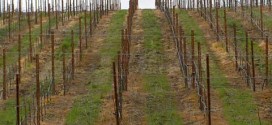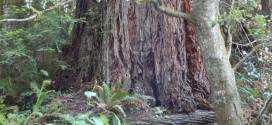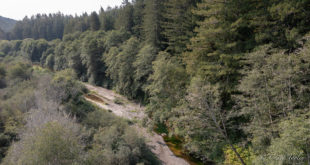| A version of this article was published in the Independent Coast Observer on August 12, 2005. |
Evans Ridge is a complex vineyard project
By Julie Verran
Courtesy Independent Coast Observer, Gualala, CA
Coastal residents were stunned in 1999 by a proposal by vineyard developer William Hill for 10,000 acres of grapes on local ridges. Last week the first project on Hill’s Preservation Ranch in Annapolis was unveiled.
The 1999 Hill proposal was for the 60,000-acre Longview tract of Coastal Forestlands property, which extended from Annapolis to Manchester.
Now, three entities split the tract: The Conservation Fund’s 24,000 acres in the Garcia River watershed; Coastal Ridges’ 15,000 acres in the Gualala River watershed in Mendocino County; and Preservation Ranch with the southernmost 19,000 acres, in Sonoma County.
Hill’s part of the former Longview tract was largely funded by the California Public Employees Retirement System. The Conservation Fund’s share had a public funds boost from the California Coastal Conservancy.
The Evans Ridge vineyard project is not a forestland conversion, the bane of environmental groups because unlike logging, which removes the trees, conversion to vineyards removes the forest.
Evans Ridge, located about halfway as the crow flies between Horicon School and Soda Springs Reserve, was an old apple and fig orchard. Some grape vines and fig trees survive around a house that PR plans to preserve, according to Sam Ausburn, the vineyard manager. He is from Sebastopol and this is his first big vineyard project.
He learned viticulture at Santa Rosa Junior College and UC Davis, Ausburn told the group from the Gualala River Watershed Council. Walt Chavoor, who manages the Kendall-Jackson vineyard the tour visited later, asked if the GRWC is all about temperature and sediment.
The watershed council’s lead volunteer, Kathleen Morgan, said the Gualala River is federally listed as impaired for sediment and temperature, and there is a lot more to it than that, such as buffers to keep sediment out of streams and shade to keep them cool. The GRWC also has a project returning large pieces of wood to streams to provide cover for young salmon and steelhead.
Henry Alden, forest manager for Gualala Redwoods Inc., said that GRI is working with the engineering firm Winzler and Kelly to upgrade the Preservation Ranch roads to help reduce erosion into streams. The same firm is doing an Environmental Impact Report that is “still in the works,” Ausburn said.
After clearing the old orchard, PR started grading at the beginning of June for a water system. Underground drains will collect rainwater and convey it via a series of catch basins at ground level to a reservoir for later use, Ausburn said.
The earth removed from the reservoir excavation was all returned to the hole and compacted. Next, the depression will be lined. The rest of the vineyard was retained at its original grade as much as possible to preserve the topsoil for vines.
A pump station will deliver water from the pond to the vines. “Basically, we’re recycling the water,” Ausburn said. The site is mostly flat.
“It’s a beautiful place for pinot noir,” he added. The site was approved by Sonoma County, he said. An erosion control plan also needs county approval.
The vineyard will be all organic, Ausburn went on, but that does not mean no chemicals will be used; only those chemicals approved for organic use, such as sulphur.
As he spoke, the fog bank was rising beyond the coastal ridge. “The pinot loves fog, and fog loves pinot,” said Ausburn. It may be three years before the vines secured from a number of different nurseries will start to bear.
Soil engineers study which type of rootstock is suitable for a particular site, and a bud of grape-bearing pinot stock will be grafted. Preservation Ranch can buy rootstock already grafted with the vine they want, or they can do the grafting themselves.
“You pay big money for good grafters,” said Chavoor.
Ausburn and Tom Piper will be in charge of the farming operation, plus a tractor driver and a small crew. Twenty acres is not big enough for a full-time crew all the time. They will hand pick most grapes.
“Machine picking will knock the berries off and leave stems on the vines,” Ausburn said. “In wine making they want clusters.”
“A lot of us don’t want to disturb the soil any more than we have to,” added Chavoor. He hasn’t had to spray an insecticide at the Kendall-Jackson site in Annapolis, where the tour went next.
Out of 900 acres, 149 were planted in grapevines, which started to bear three years ago. The rest of the acreage is forestland along the Wheatfield Fork of the Gualala River. Chavoor showed the group a reservoir that he thinks works the way the one at Evans Ridge will.
The Kendall-Jackson reservoir fills in as short a time as two weeks, Chavoor said. The rest of the rainwater that flows off the vineyard is released to the river. He said this should answer the environmental objection that a number of such ridge-top reservoirs could take so much water out of the system that the Gualala River could run dry, harming salmon and steelhead.
Chavoor also has an answer to the objection that wine is a luxury item with little social value. He said his family spends a half-hour more at dinner when wine is on the table, and that is half an hour less that the children watch television or play video games.
# # #
 Friends of Gualala River Protecting the Gualala River watershed and the species living within it
Friends of Gualala River Protecting the Gualala River watershed and the species living within it


